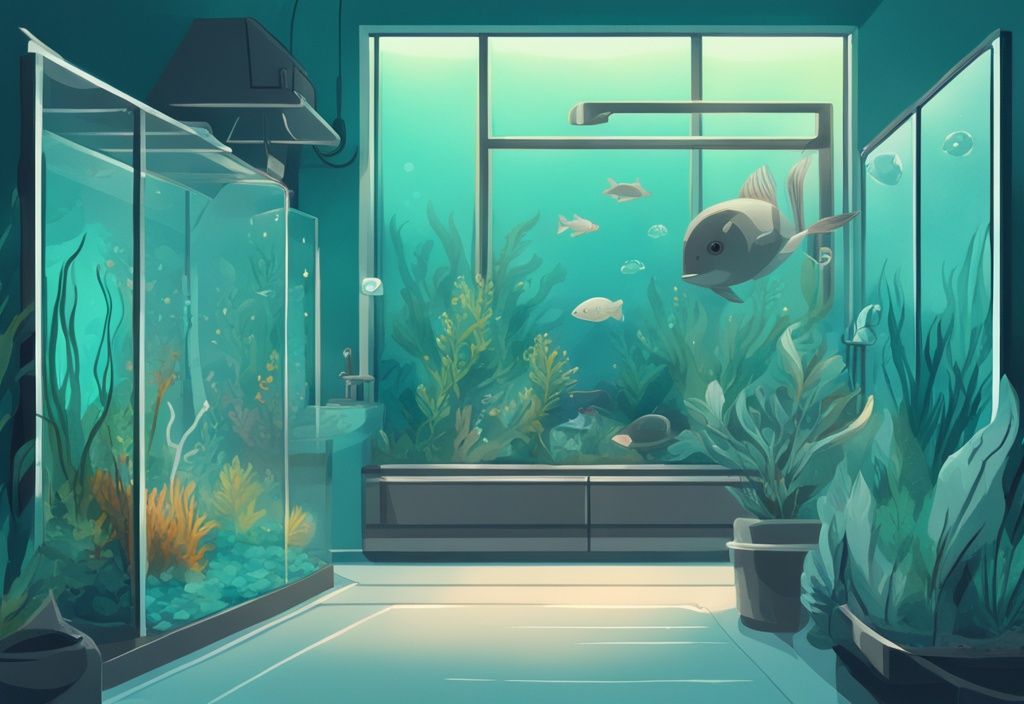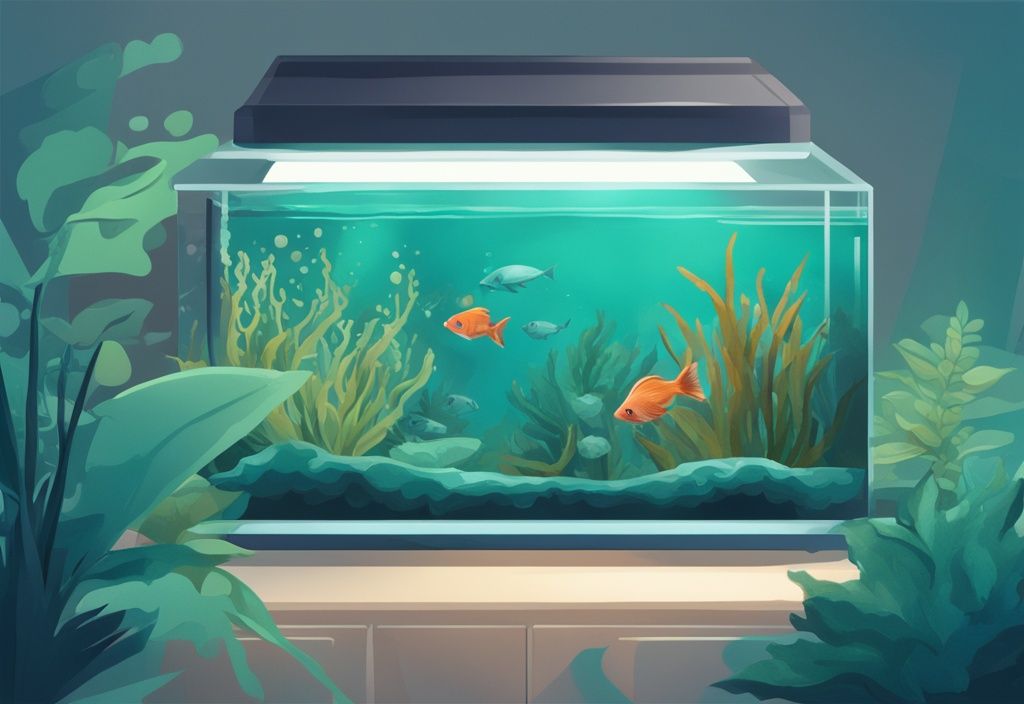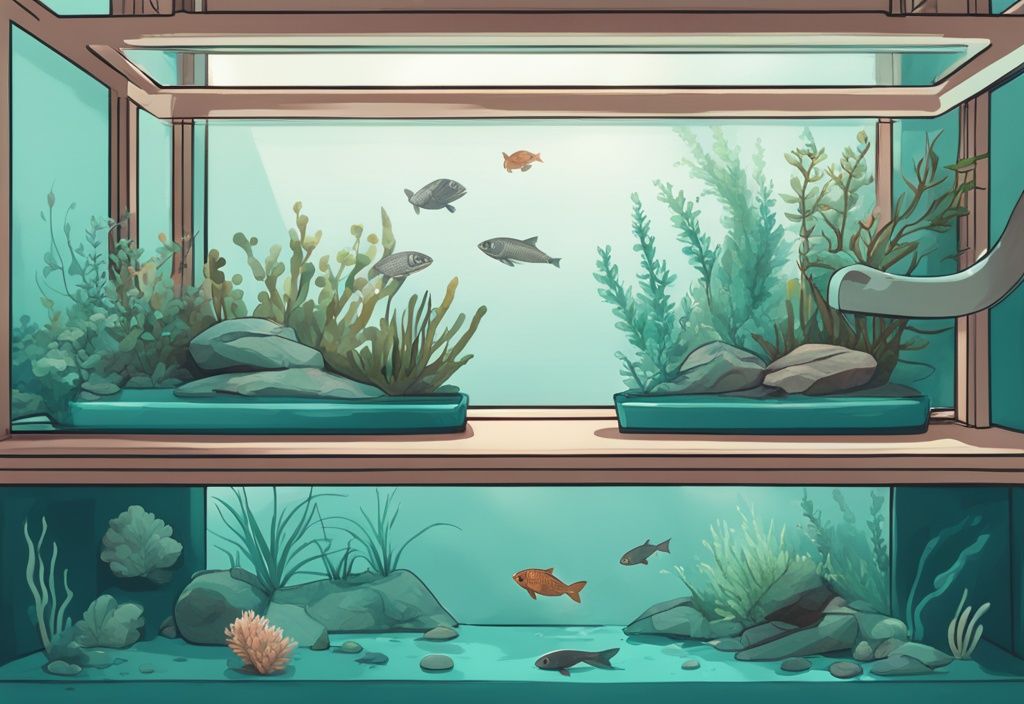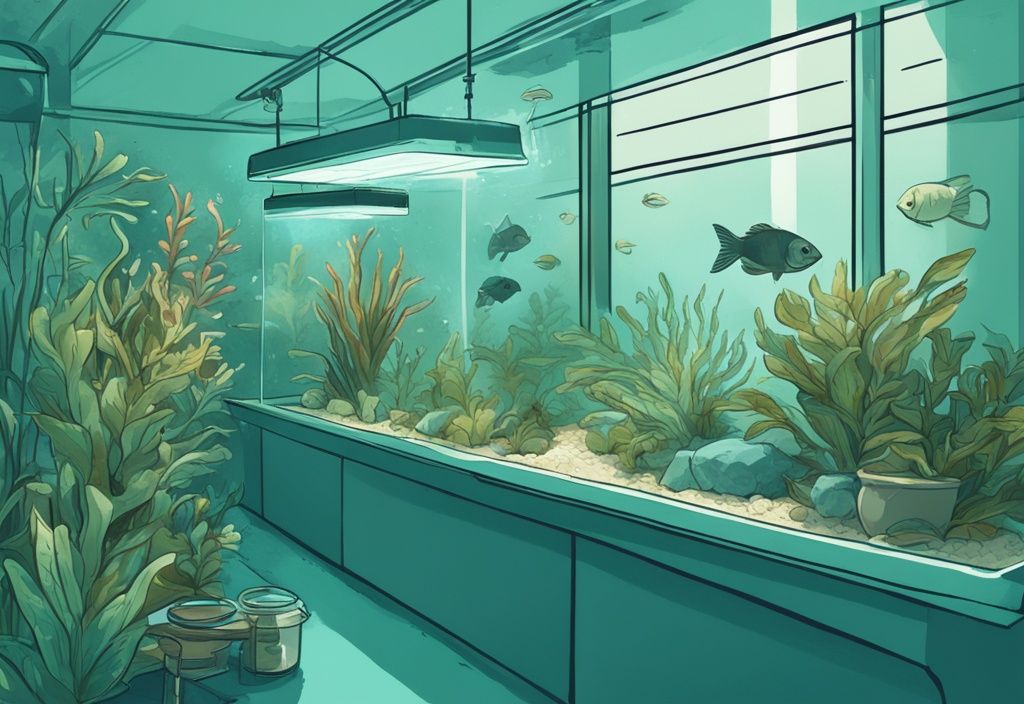Imagine a vibrant underwater world that thrives with minimal effort on your part. A low maintenance aquarium offers just that—an oasis of aquatic life that requires less time and energy to maintain, making it a perfect choice for busy individuals or those new to fish keeping. These aquariums are not only visually stunning but also designed to simplify the care process, allowing you to enjoy the beauty of nature without the usual hassle.
In this comprehensive guide, we’ll explore the essentials of creating and maintaining a low maintenance aquarium. From selecting the right equipment, such as quality filtration systems and automatic feeders, to choosing hardy fish species that thrive with minimal intervention, we cover it all. You’ll learn how to set up a balanced ecosystem and discover expert tips to avoid common pitfalls.
Whether you’re a seasoned aquarist looking to simplify your routine or a beginner eager to dive into the world of fish keeping, this article is your go-to resource. With the right approach, you can enjoy an aquarium that not only enhances your living space but also fits seamlessly into your busy lifestyle.
Prepare to embark on a journey towards effortless aquarium mastery, where maintaining a stunning aquatic environment becomes a rewarding and stress-free experience.
What is a Low Maintenance Aquarium?
A low maintenance aquarium is a carefully crafted aquatic environment that reduces the time and effort needed for upkeep, all while supporting a flourishing habitat for fish and plants. The secret to this balance lies in selecting equipment, fish species, and plants that naturally minimize the need for frequent interventions.
Imagine an orchestra where each instrument plays in harmony—this is how a low maintenance aquarium operates. By choosing components that work seamlessly together, aquarists can enjoy the beauty of their aquariums without the constant demand for maintenance.
Low maintenance aquariums come in various forms, such as freshwater, saltwater, and planted types, each with unique requirements and strategies to ensure minimal upkeep. The right combination of these elements creates a self-sustaining ecosystem, allowing hobbyists to focus more on the enjoyment of their aquatic displays rather than on their maintenance.
Benefits of a Low Maintenance Aquarium
The primary advantage of a low maintenance aquarium is the significant reduction in time and stress associated with routine care. By minimizing the frequency and complexity of maintenance tasks, aquarists can enjoy a more relaxed experience.
In the long term, these aquariums prove to be cost-effective, as they require fewer replacements and interventions, thereby reducing overall expenses. Additionally, a low maintenance setup allows enthusiasts to appreciate the aesthetic appeal of their aquariums without the burden of constant upkeep, making it an ideal choice for those with busy lifestyles.
This approach not only enhances the enjoyment of the hobby but also ensures a healthier environment for aquatic life. The ecosystem is designed to be more stable and self-regulating, fostering a thriving underwater world where both fish and plants can flourish.
Choosing the Right Equipment for a Low Maintenance Aquarium
Creating a low maintenance aquarium is all about making smart equipment choices that work in harmony to sustain a thriving aquatic environment. From filtration systems to automatic feeders, each component plays a critical role in reducing upkeep while promoting the health of your fish and plants.

Importance of Quality Filtration Systems
Investing in a quality filtration system is like hiring a diligent housekeeper for your aquarium. A robust filter ensures optimal water quality and significantly cuts down on the need for frequent water changes. Imagine it as the lungs of your tank, keeping everything fresh and breathable. The trick is to pick a filter that matches your tank’s size and can handle the bio-load of your fish. This way, waste and toxins are efficiently whisked away, creating a balanced ecosystem. A well-chosen filtration system is your ticket to a stable environment, crucial for minimizing maintenance and keeping your aquatic friends happy.
Role of Reliable Heating and Lighting
Think of reliable heating and lighting as the sun and seasons for your aquarium. A dependable heater maintains a stable temperature, which is vital for the well-being of both fish and plants. Consistent temperatures prevent stress and health issues in fish, saving you from playing the role of a fish doctor. Quality lighting supports the growth of aquatic plants and helps maintain a natural day-night cycle, much like the gentle rhythm of sunrise and sunset. Incorporating timers can automate lighting schedules, easing maintenance by ensuring a consistent environment without manual adjustments.
Benefits of Automatic Feeders and Timers
Automatic feeders and timers are like the personal assistants of the aquarium world. Automatic feeders provide a consistent feeding schedule, especially handy when you’re busy or away. This consistency helps prevent overfeeding, a common pitfall that can lead to murky waters. Timers are the unsung heroes, maintaining regular lighting and feeding schedules, contributing to a stable and stress-free environment for your fish. By reducing the manual effort required for daily tasks, these tools let you enjoy your aquarium with minimal intervention, leaving more time to admire your underwater haven.
Planning and Setting Up Your Low Maintenance Aquarium
Creating a low maintenance aquarium is a rewarding endeavor that combines beauty and simplicity. This guide will walk you through the essential steps, from selecting the ideal tank size to establishing a balanced ecosystem, ensuring your aquatic habitat thrives with minimal effort.
Selecting the Ideal Tank Size and Type
Choosing the right tank size is a pivotal step in setting up a low maintenance aquarium. Opt for a smaller tank, such as a 20-gallon long or a 30-gallon bowfront. These sizes can significantly reduce the frequency of maintenance tasks. Smaller tanks are generally more forgiving when it comes to water quality fluctuations, making them easier to manage for both beginners and busy aquarists. The compact size not only simplifies routine care but also ensures that you can maintain a healthy environment for your aquatic life with minimal effort.
Choosing Hardy and Adaptable Fish Species
Selecting the right fish species is crucial for a low maintenance aquarium. Hardy and adaptable species like guppies, platies, and bettas for freshwater setups, or damselfish and clownfish for saltwater tanks, are excellent choices. These species are known for their resilience to varying water conditions, which reduces the need for constant monitoring and adjustments. Additionally, understocking your tank can help prevent overpopulation, further minimizing maintenance by keeping the ecosystem balanced and reducing the bio-load on the filtration system.
Creating a Simple and Effective Aquascape
An effective aquascape for a low maintenance aquarium should be simple yet functional. By maintaining a minimalistic design with limited substrate and decorations, you can significantly reduce the time and effort required for upkeep. Incorporating low-maintenance plants such as Anubias, Java fern, or Java moss can enhance the aesthetic appeal while requiring minimal care. Choosing a substrate like gravel or sand that supports plant growth can also contribute to a thriving aquatic environment, making your aquarium both beautiful and easy to maintain.
Establishing a Balanced Ecosystem
Creating a balanced ecosystem is essential for a low maintenance aquarium. This involves the right combination of fish, plants, and equipment to naturally maintain water quality. Live plants like Java fern and Amazon swords play a vital role by absorbing nitrates, thus contributing to cleaner water. Regular observation and minor adjustments are key to preventing larger issues, ensuring that your aquarium remains a healthy and stable environment for its inhabitants. By fostering a self-sustaining ecosystem, you can enjoy the beauty of your aquarium with minimal intervention.
Maintaining Your Low Maintenance Aquarium
A low maintenance aquarium thrives on consistent care and attention. This section delves into the essentials of routine water changes and parameter monitoring, ensuring your aquatic environment remains healthy and vibrant.

Guide to Routine Water Changes and Testing
Regular water changes are the backbone of a low maintenance aquarium. Picture it as giving your underwater world a fresh breath of air. Aim to replace 30-50% of the water weekly. This simple act helps whisk away waste and toxins, keeping the environment pristine.
Establishing a routine is like setting a rhythm for your aquarium’s symphony. Your schedule should include not just water changes, but also filter cleaning and equipment checks. Think of it as a spa day for your fish, ensuring everything runs smoothly. Regular maintenance thwarts the buildup of harmful substances and keeps your equipment in top shape.
Frequent water testing is your early warning system. Monitoring parameters such as pH, ammonia, and nitrate levels is akin to checking the vital signs of your aquatic life. It allows you to catch potential issues early, enabling timely interventions to maintain a balanced ecosystem.
Monitoring Water Parameters for Healthy Fish
Consistent monitoring of water parameters is like having a health check-up for your fish. Keeping an eye on water temperature, pH, and ammonia levels helps maintain stability, reducing stress on your aquatic friends. Use reliable test kits to regularly assess these parameters, making necessary adjustments to keep them within ideal ranges.
Stable water conditions are your secret weapon in minimizing maintenance efforts. They ensure the health of your fish, reducing the likelihood of stress-induced illnesses. By maintaining a consistent environment, you’re enhancing the longevity and vibrancy of your aquarium inhabitants, making your low maintenance aquarium a thriving underwater haven.
Expert Tips for a Successful Low Maintenance Aquarium
Creating a low maintenance aquarium is all about achieving a harmonious balance. By understanding the needs of your aquatic friends and setting up a sustainable environment, you can enjoy a thriving aquarium with minimal effort. Let’s dive into some expert strategies to help you avoid common pitfalls and maintain a healthy, low maintenance aquatic ecosystem.
Avoiding Common Aquarium Mistakes
Picture this: your aquarium as a bustling underwater city. Overfeeding is like throwing a feast every day—sounds fun, but it leads to chaos and poor water quality. Feed your fish just enough for them to finish in a few minutes. This keeps the water clean and the maintenance low.
Think of your tank as a cozy apartment. Overcrowding it with too many fish can lead to stress and more cleaning. Aim for a relaxed, understocked environment where each fish has its own space to thrive. This balance is key to a low maintenance aquarium.
Sharing the responsibility of aquarium care is like having a family chore chart. Make sure everyone knows the basics, like feeding schedules and water testing. Initially, you might need to roll up your sleeves a bit more as the tank settles. But soon, you’ll have a stable environment that practically takes care of itself.

Using Algae Eaters to Keep the Tank Clean
Algae in your tank? Think of it as nature’s way of redecorating. But too much can be overwhelming. Enter algae eaters—your tank’s cleaning crew. Snails and shrimps are fantastic at munching away the green stuff, reducing the need for manual scrubbing.
However, keep an eye on those snails. They can multiply faster than you can say “overpopulation.” A balanced number of algae eaters will help maintain a clean tank without much effort on your part.
Maintaining a Stable Temperature
Imagine your fish in a cozy, temperature-controlled home. A reliable heater is like their personal thermostat, keeping things just right. Sudden temperature changes? They’re like surprise roller coasters for fish—stressful and disruptive.
Regularly check your heater to ensure it’s doing its job. This proactive step keeps your fish calm and your maintenance routine simple. A stable temperature means a happy, low maintenance aquarium.
FAQ
What fish are best for a low maintenance aquarium?
Imagine a bustling underwater city where the inhabitants thrive with minimal fuss. Hardy and adaptable species like guppies, platies, and bettas for freshwater, and damselfish and clownfish for saltwater, are your go-to residents. These resilient fish are like the superheroes of the aquatic world, effortlessly adapting to varying conditions and making your aquarium journey smooth and enjoyable.
How often should I clean my low maintenance aquarium?
Think of your aquarium as a tiny ecosystem that needs a bit of TLC to flourish. Regular water changes of 30-50% weekly are like giving your fish a fresh breath of air. Pair this with routine filter cleaning and equipment checks, and you’ll maintain optimal water quality, ensuring your aquatic friends live in a healthy environment. It’s like giving your fish a spa day every week!
Can I have a low maintenance saltwater aquarium?
Absolutely! With a little planning, your saltwater aquarium can be a serene ocean corner in your home. By selecting hardy saltwater species and investing in quality equipment, you create a setup that requires minimal intervention. It’s like having a self-sustaining mini ocean, where the balance of nature is beautifully maintained with just a gentle nudge from you.
Do I need live plants in a low maintenance aquarium?
Live plants like Java fern and Amazon swords are the unsung heroes of aquariums. They act like natural filters, absorbing nitrates and reducing the need for frequent maintenance. Think of them as the green guardians of your tank, contributing to a balanced ecosystem and offering your fish a slice of nature’s tranquility.
What is the ideal tank size for a low maintenance setup?
Choosing the right tank size is like finding the perfect home for your aquatic community. A 20-gallon long or 30-gallon bowfront tank strikes a harmonious balance between space and ease of maintenance. It’s spacious enough for your fish to thrive yet manageable enough to keep your maintenance routine relaxed and enjoyable.
